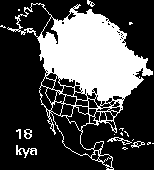
The Land of Illinois
This section of the History of Illinois Agriculture will include information and images about the creation of Illinois soils. Farmers, in oral histories, talk about soil types and how they prepare and manage soil.
The glaciers of the Ice Ages formed the soils and terrain of today's Illinois. The northeastern and central areas of the state are very flat where the last glacier ground up rock and soil in its path. It deposited sand, gravel, dirt, and some rocks from farther north when it melted. Dust and sand also blew onto land surrounding the edges of the glaciers. All these deposits make up the fertile soil of the central area.
There are also areas of the state that the glaciers did not change. In the far northwestern and southern parts of Illinois, there is hilly, forested terrain that does not have glacial drift as a topsoil.
The rivers of Illinois and their seasonal flooding also affect soil and agriculture. In the flat prairies, water stood for months after heavy rains. Farmers and communities drained acreage before they farmed. In other areas, such as along the Illinois River, dams were built to prevent flooding.
Each natural section of Illinois helped determine the type of farming that developed there. There are cattle ranches in western Illinois and orchards and vineyards in the south, as well as the wheat, corn, and soybean fields.







